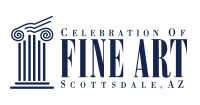
Seth Fairweather is equal parts artist and solutionist. In fact, he’s crafted his occupation around solving puzzles. But these are no ordinary puzzles. Instead of the typical jigsaw-cut cardboard, Seth uses materials that are far more challenging: glass, metal and bronze.
But the thrill of a challenge is a big part of what fuels this talented sculpture artist to continually test new concepts and push the boundaries of what’s been done before.
“It’s about chasing that high of solving the problem and figuring out how to do something that no one else has done,” he said.
And this is what led to one of his most ambitious projects to date: stacked-glass sculptures that tower well above 10 feet tall. These pieces were a year in the making, involving research, experimentation and problem solving at nearly every step along the journey. But Seth wouldn’t have it any other way.

Read on or watch the video below to learn more about Seth and his journey as a sculpture artist.
When did you know art was your calling?
I had an art requirement I had to get out of the way when I was in school and I took glass blowing and just never wanted to do anything else. I realized when I was breaking into the studio to work at 3 o’clock in the morning and staying until they’d throw me out at midnight, that I hadn’t really been that enthusiastic about anything else.
I was in New Orleans [for school] and I was somewhere in town with a couple of friends from school and we were talking about what we were all working on, because there were engineers and pre-med and linguists and all kinds of different majors. I was feeling a little lost at the time and said all I want to do is arts and crafts all day. And then someone said, “Well, then why don’t you just do that?”. And it was the first time I really thought about actually just doing that. So that was kind of a turning point.
How has your work evolved?
Technically it’s gotten better, I think. Conceptually, it’s gotten to be more developed and edited. I think that starting out, I was probably a little too heavy-handed in trying to push ideas across. And a lot of my work now is a little more subtle. It’s more nuanced rather than punching you in the face with the idea.
What do you love most about creating art?
I like problem solving. I like being faced with an idea of something I want to make and not knowing how to do it and having to figure out how to do it. It’s why my work tends to change year to year. I get asked every year if this is my first year [at the Celebration of Fine Art]. And a lot of it has to do with I don’t want to just regurgitate and do the same thing that I already know how to do. What excites me is the problem solving.
What has been your most challenging project?
These new stacked pieces. It was about a year and a half of research and development, and experimenting––building something and then saying, “This isn’t good enough,” and throwing it away. Then refining and troubleshooting. Then figuring out how to move them and how to install them safely. These were the hardest things I’ve taken on so far.
What keeps you coming back to the Celebration of Fine Art?
This show was a turning point. Until I did this show, I had a day job. I had to work to support a family and this was what I wanted to be doing. I would do it as much as I could, but it wasn’t anything I could do as a job. This show was the first time I was able to really get in front of a group of people that were able to start collecting the stuff I was making. And that gave me the freedom and the confidence to start developing more work––more refined work. I was able to spend more time in galleries and keep doing this show. So this show was the turning point for me being able to transition into making this kind of work full time.

